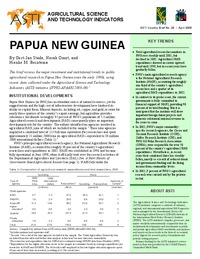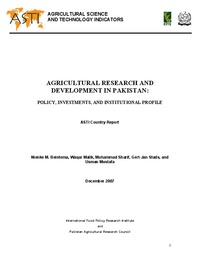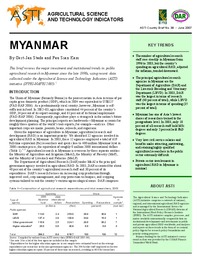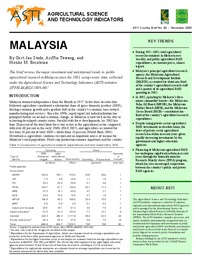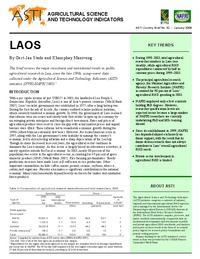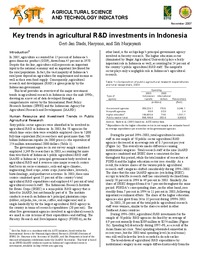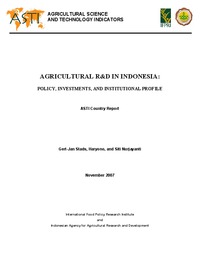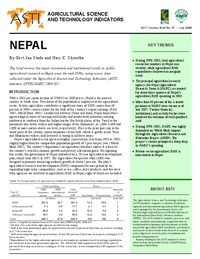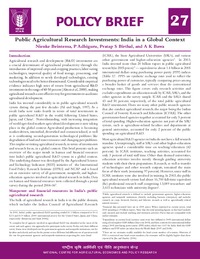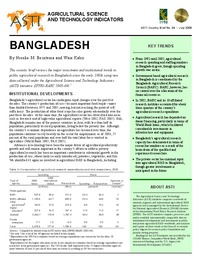Authors:
Stads, Gert-Jan; Omot, Norah; Beintema, Nienke
Year:
2005
Publisher
International Food Policy Research Institute (IFPRI); and National Agricultural Research Institute (NARI)
Back to:
Total fte agricultural researcher numbers in PNG rose steadily until 2001 and thereafter contracted as a result of restructuring and retrenchment of less productive staff. The country’s agricultural R&D expenditures followed a more erratic trend. NARI struggled in its first years of operation, but a change in government brought renewed support and a commitment to ongoing funding. NARI is now expected to be able to draw important foreign donor projects and generate substantial internal revenues from its activities in the years to come.
Authors:
Beintema, Nienke; Malik, Waqar; Sharif, Muhammad; Stads, Gert-Jan; Mustafa, Usman
Year:
2007
Publisher
International Food Policy Research Institute (IFPRI); and Pakistan Agricultural Research Council (PARC)
Back to:
With nearly 3,600 fte researchers in 2003, Pakistan has one of the largest agricultural R&D systems in Asia. However, agricultural researcher totals in Pakistan have increased only slowly during the past two decades, mainly as a result of prolonged periods of recruitment restrictions. In addition, at just 15 percent in 2003, the share of Pakistani agricultural research staff trained to PhD level is relatively low, compared to some of Pakistan’s South Asian neighbors.
Authors:
Stads, Gert-Jan; Kam, Pau Sian
Year:
2007
Publisher
International Food Policy Research Institute (IFPRI); and Department of Agriculture (DAR)
Back to:
The number of fte researchers employed in agriculture in Myanmar increased gradually during 1996–2003, but real spending on agricultural R&D declined. In 2003, Myanmar invested just 8 million dollars in 2000 international prices on agricultural R&D, which is extremely low given the country’s size and the importance of the agricultural sector to the national economy. Both the country’s average spending per agricultural scientist and its research intensity ratio are among the lowest in
Authors:
Stads, Gert-Jan; Tawang, Ariffin; Beintema, Nienke
Year:
2005
Publisher
International Food Policy Research Institute (IFPRI); and Malaysian Agricultural Research and Development Institute (MARDI)
Back to:
Although MASTIC reported that agricultural R&D accounted for only 4 percent of Malaysia’s public and private research spending in 2002 (MASTIC 2004), the sector experienced strong growth in terms of human resources and spending from 1981 until 2002. Total fte agricultural researchers rose steadily during this period, and the country’s public agricultural R&D expenditures nearly tripled over this time frame, reaching $384 million in constant 2000 prices. Agencies focusing on export plantation crops in particular reported significant increases in their total spending levels.
Authors:
Stads, Gert-Jan; Manivong, Khamphay
Year:
2006
Publisher
International Food Policy Research Institute (IFPRI); and National Agriculture and Forestry Research Institute (NAFRI)
Back to:
Overall, agricultural researcher totals in Laos increased during 1998–2003, while the country’s agricultural R&D expenditures followed a more irregular trend. With the creation of NAFRI in 1999 through the amalgamation of the country’s nine existing research centers, total agricultural research spending grew immediately. It nevertheless dropped sharply in subsequent years and by 2003 had fallen 60 percent below its 1999 level (to $11 million in 2000 international dollars). This decline was less severe, however, when expressed in current Lao kip.
Authors:
Stads, Gert-Jan; Haryono; Nurjayanti, Siti
Year:
2007
Publisher
International Food Policy Research Institute (IFPRI); and Indonesian Agency for Agricultural Research and Development (IAARD)
Back to:
In 2005, agriculture accounted for 15 percent of Indonesia’s gross domestic product (GDP), down from 45 percent in 1970. Despite this decline, agriculture still represents an important input to the national economy and an important livelihood for the rural population. In fact, the vast majority of Indonesia’s rural poor depend on agriculture for employment and income as well as their own food supply. Consequently, agricultural research and development (R&D) is given priority by the Indonesian government.
Authors:
Stads, Gert-Jan; Haryono; Nurjayanti, Siti
Year:
2007
Publisher
International Food Policy Research Institute (IFPRI); and Indonesian Agency for Agricultural Research and Development (IAARD)
Back to:
Indonesia’s total number of agricultural researchers in Indonesia fell slightly during 1994–2003 due to major reorganizations in government-led agricultural R&D. Nevertheless, with close to 5,000 fte researchers in 2003, Indonesia has one of the largest agricultural research systems in Asia. Despite the decline in researcher totals, qualifications of Indonesian agricultural research staff improved steadily in recent years, principally due to donor-financed training programs. Due to the Asian financial crisis, agricultural R&D spending has been severely cut since 1997.
Authors:
Stads, Gert-Jan; Shrestha, Hari K.
Year:
2006
Publisher
International Food Policy Research Institute (IFPRI); and Nepal Agricultural Research Council (NARC)
Back to:
Overall, agricultural researcher numbers in Nepal increased during 1996–2003, while the country’s agricultural R&D expenditures followed a more irregular trend. Nepal’s principal agricultural R&D agency, NARC, was highly dependent on the World Bank-financed project AREP, which ran from 1998 until 2002. The closure of this project led to a sharp fall in the council’s and the country’s agricultural R&D spending, prompting the Nepalese government to increase its funding to NARC.
Authors:
Beintema, Nienke; Adhiguru, P.; Birthal, Pratap S.; Bawa, A. K.
Year:
2008
Publisher
International Food Policy Research Institute (IFPRI); and National Centre for Agricultural Economics and Policy Research (NCAP)
Back to:
Agricultural research and development (R&D) investments are a crucial determinant of agricultural productivity through the introduction of improved crops and cropping practices, labor-saving technologies, improved quality of food storage, processing , and marketing. In addition to newly developed technologies, existing technologies need to be better disseminated.
Authors:
Beintema, Nienke; Kabir, Wais
Year:
2006
Publisher
International Food Policy Research Institute (IFPRI); and Bangladesh Agricultural Research Council (BARC)
Back to:
Overarching responsibility for the coordination of public agricultural research in Bangladesh lies with BARC, which is responsible for planning, integration, implementation, and evaluation of research.

